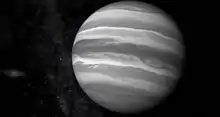HD 28185 b
HD 28185 b is an extrasolar planet approximately 128.6 light-years away from Earth in the constellation of Eridanus. The planet was discovered orbiting the Sun-like star HD 28185 in April 2001 as a part of the CORALIE survey for southern extrasolar planets, and its existence was independently confirmed by the Magellan Planet Search Survey in 2008.[2] HD 28185 b orbits its sun in a circular orbit that is at the inner edge of its star's habitable zone.[3]
 An artist's impression of HD28185 b | |
| Discovery | |
|---|---|
| Discovered by | Santos et al. |
| Discovery site | |
| Discovery date | April 4, 2001[1] |
| Radial velocity (CORALIE) | |
| Orbital characteristics | |
| 1.031 ± 0.060 AU (154,200,000 ± 9,000,000 km) | |
| Eccentricity | 0.070 ± 0.040 |
| 383.0 ± 2.0 d | |
| 2,451,863 ± 26 | |
| 351 ± 25 | |
| Semi-amplitude | 161 ± 11 |
| Star | HD 28185 |
Discovery
HD 28185 b was discovered by detecting small periodic variations in the radial velocity of its parent star caused by the gravitational attraction of the planet. This was achieved by measuring the Doppler shift of the star's spectrum. In 2001 it was announced that HD 28185 exhibited a wobble along the line-of-sight with a period of 383 days, with an amplitude indicating a minimum mass 5.72 times that of Jupiter.[1][4]
Orbit and mass
HD 28185 b takes 1.04 years to orbit its parent star. Unlike most known long-period planets, the orbit of HD 28185 b has a low eccentricity, comparable to that of Mars in the Solar System.[5] The orbit lies entirely within its star's habitable zone.[3]
The amplitude of the radial velocity oscillations means that the planet has a mass at least 5.7 times that of Jupiter in the Solar System. However, the radial velocity method only yields a minimum value on the planet's mass, depending on the orbital inclination to our line-of-sight. Therefore, the true mass of the planet may be much greater than this lower limit.
Characteristics
Given the planet's high mass, it is most likely to be a gas giant with no solid surface. Since the planet has only been detected indirectly through observations of the star, properties such as its radius, composition, and temperature are unknown.
Since HD 28185 b orbits in its star's habitable zone, some have speculated on the possibility of life on worlds in the HD 28185 system.[6] While it is unknown whether gas giants can support life, simulations of tidal interactions suggest that HD 28185 b could harbor Earth-mass satellites in orbit around it for many billions of years.[7] Such moons, if they exist, may be able to provide a habitable environment, though it is unclear whether such satellites would form in the first place.[8] Additionally, a small planet in one of the gas giant's Trojan points could survive in a habitable orbit for long periods.[9] The high mass of HD 28185 b, of over six Jupiter masses, actually makes either of these scenarios more likely than if the planet was about Jupiter's mass or less.
References
- "Exoplanets: The Hunt Continues!" (Press release). Garching, Germany: European Southern Observatory. April 4, 2001. Retrieved December 27, 2012.
- Minniti, Dante; et al. (2009). "Low-Mass Companions for Five Solar-Type Stars From the Magellan Planet Search Program". The Astrophysical Journal. 693 (2): 1424–1430. arXiv:0810.5348. Bibcode:2009ApJ...693.1424M. doi:10.1088/0004-637X/693/2/1424.
- Jones, Barrie W.; Sleep, P. Nick; Underwood, David R. (2006). "Habitability of Known Exoplanetary Systems Based on Measured Stellar Properties". The Astrophysical Journal. 649 (2): 1010–1019. arXiv:astro-ph/0603200. Bibcode:2006ApJ...649.1010J. doi:10.1086/506557.
- Santos, N.; et al. (2001). "The CORALIE survey for southern extra-solar planets VI. New long-period giant planets around HD 28185 and HD 213240". Astronomy and Astrophysics. 379 (3): 999–1004. arXiv:astro-ph/0106255. Bibcode:2001A&A...379..999S. doi:10.1051/0004-6361:20011366. Archived from the original on 2006-07-13.
- Butler, R. P.; et al. (2006). "Catalog of Nearby Exoplanets". The Astrophysical Journal. 646 (1): 505–522. arXiv:astro-ph/0607493. Bibcode:2006ApJ...646..505B. doi:10.1086/504701.
- Mullen, L. (2001). "Extrasolar Planets with Earth-like Orbits". Archived from the original on 29 September 2006. Retrieved 22 July 2006.
- Barnes, J., O'Brien, D. (2002). "Stability of Satellites around Close-in Extrasolar Giant Planets". Astrophysical Journal. 575 (2): 1087–1093. arXiv:astro-ph/0205035. Bibcode:2002ApJ...575.1087B. doi:10.1086/341477.CS1 maint: multiple names: authors list (link)
- Canup, R., Ward, W. (2006). "A common mass scaling for satellite systems of gaseous planets". Nature. 441 (7095): 834–839. Bibcode:2006Natur.441..834C. doi:10.1038/nature04860. PMID 16778883.CS1 maint: multiple names: authors list (link)
- Schwarz, R.; Dvorak, R.; Süli, Á.; Érdi, B. (2007). "Survey of the stability region of hypothetical habitable Trojan planets". Astronomy and Astrophysics. 474 (3): 1023–1029. Bibcode:2007A&A...474.1023S. doi:10.1051/0004-6361:20077994.
External links
| Wikimedia Commons has media related to HD 28185 b. |
- "HD 28185". Exoplanets. Archived from the original on 2016-03-03. Retrieved 2008-11-01.